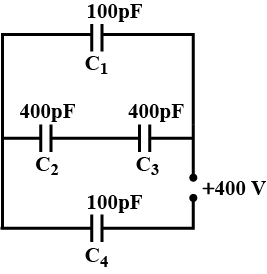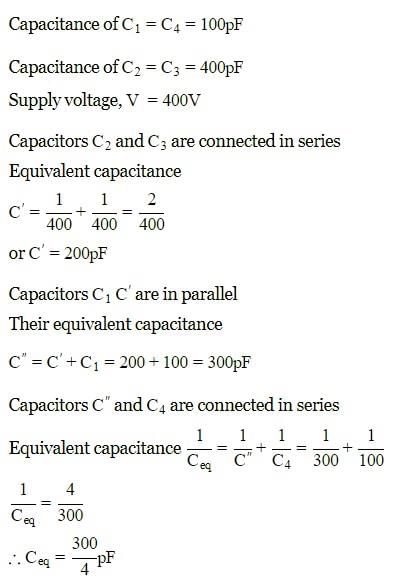All Exams >
NEET >
NCERT Based Tests for NEET >
All Questions
All questions of Electrostatic Potential and Capacitance for NEET Exam
Two charged conducting spheres of radii a and b are connected to each other by a wire. The ratio of electric fields at the surfaces of two spheres is- a)a/b
- b)b/a
- c)a2/b2
- d)b2/a2
Correct answer is option 'B'. Can you explain this answer?
Two charged conducting spheres of radii a and b are connected to each other by a wire. The ratio of electric fields at the surfaces of two spheres is
a)
a/b
b)
b/a
c)
a2/b2
d)
b2/a2
|
|
Mira Joshi answered |
Let q1 and q2 be the charges and C1 and C2 be the capacitance of two spheres
The charge flows from the sphere at higher potential to the other at lower potential, till their potentials becomes equal.
After sharing, the charges on two spheres would be
q1/q2 = C1V/C2V…(i)
Also C1C2 = ab…(ii)
From (i) q1/q2 = a/b
Ratio of surface charge on the two spheres
σ1/σ2 = q1/4πa2⋅4πb2/q2 = q1/q2⋅b2/a2 = b/a(using(ii)
∴ The ratio of electric fields at the surfaces of two spheres E1/E2 = σ1/σ2 = b/a
The charge flows from the sphere at higher potential to the other at lower potential, till their potentials becomes equal.
After sharing, the charges on two spheres would be
q1/q2 = C1V/C2V…(i)
Also C1C2 = ab…(ii)
From (i) q1/q2 = a/b
Ratio of surface charge on the two spheres
σ1/σ2 = q1/4πa2⋅4πb2/q2 = q1/q2⋅b2/a2 = b/a(using(ii)
∴ The ratio of electric fields at the surfaces of two spheres E1/E2 = σ1/σ2 = b/a
In a parallel plate capacitor, the capacity increases if- a)area of the plate is decreased
- b)distance between the plates increases
- c)area of the plate is increased
- d)dielectric constant decreases
Correct answer is option 'C'. Can you explain this answer?
In a parallel plate capacitor, the capacity increases if
a)
area of the plate is decreased
b)
distance between the plates increases
c)
area of the plate is increased
d)
dielectric constant decreases
|
|
Muraad answered |
Since C = AEô/d
therefore, capacitance is proportional to area
as, the area increases capacitance also increases.
therefore, capacitance is proportional to area
as, the area increases capacitance also increases.
Two capacitors, 3μF and 4μF, are individually charged across a 6V6V battery. After being disconnected from the battery, they are connected together with the negative plate of one attached to the positive plate of the other. What is the final total energy stored- a)1.26 × 10−4J
- b)2.57 × 10−4J
- c)1.25 × 10−6J
- d)2.57 × 10−6J
Correct answer is option 'D'. Can you explain this answer?
Two capacitors, 3μF and 4μF, are individually charged across a 6V6V battery. After being disconnected from the battery, they are connected together with the negative plate of one attached to the positive plate of the other. What is the final total energy stored
a)
1.26 × 10−4J
b)
2.57 × 10−4J
c)
1.25 × 10−6J
d)
2.57 × 10−6J
|
|
Gaurav Kumar answered |
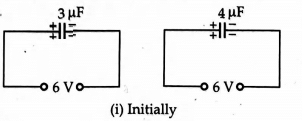
As Q = CV
∴ Initially the charge on each capacitor is
Q1 = C1V1 = (3μF)(6V) = 18μC
and Q2 = C2V2 = (4μF)(6V) = 24μC
When two capacitors is are joined to each other such that negative plate of one is attached with the positive plate of the other. The charges Q1 and Q2 are redistributed till they attain the common potential which is given by.
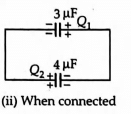
Common potential V = Total Charge/Total capacitance

Final energy stored,

The distance between H + and Cl − ions in HCl molecules is 1.38 Å. The potential due to this dipole at a distance of 10Å on the axis of dipole is- a)2.1 V
- b)1.8 V
- c)0.2 V
- d)1.2 V
Correct answer is option 'C'. Can you explain this answer?
The distance between H + and Cl − ions in HCl molecules is 1.38 Å. The potential due to this dipole at a distance of 10Å on the axis of dipole is
a)
2.1 V
b)
1.8 V
c)
0.2 V
d)
1.2 V
|
|
Dev Patel answered |
Here, 2a = 1.38 × 10−10m, r = 10 × 10−10 m charge, q = 1.6 × 10−19C
As potential,

As potential,

Which of the following statements is false for a perfect conductor?- a)The surface of the conductor is an equipotential surface
- b)The electric, field just outside the surface of a conductor is perpendicular to the surface
- c)The charge carried by a conductor is always uniformly distributed over the surface of the conductor
- d)None of the above
Correct answer is option 'D'. Can you explain this answer?
Which of the following statements is false for a perfect conductor?
a)
The surface of the conductor is an equipotential surface
b)
The electric, field just outside the surface of a conductor is perpendicular to the surface
c)
The charge carried by a conductor is always uniformly distributed over the surface of the conductor
d)
None of the above
|
|
Rajveer Mukherjee answered |
Surface of the Conductor is an Equipotential Surface
- This statement is true for a perfect conductor. In electrostatic equilibrium, the electric field inside a conductor is zero. This means that the potential is constant throughout the conductor, making the surface an equipotential surface.
Electric Field Just Outside the Surface of a Conductor is Perpendicular to the Surface
- This statement is true for a perfect conductor. Due to the properties of conductors, the electric field lines are always perpendicular to the surface. This is because any component of the electric field parallel to the surface would cause movement of charges, which is not allowed in electrostatic equilibrium.
Charge Carried by a Conductor is Always Uniformly Distributed over the Surface of the Conductor
- This statement is false for a perfect conductor. In the case of a perfect conductor, charges reside only on the surface of the conductor in electrostatic equilibrium. However, the distribution of charge may not always be uniform. For example, in the presence of external electric fields or nearby charges, the charge distribution on the surface of the conductor may not be uniform.
Therefore, the false statement for a perfect conductor is option c) "The charge carried by a conductor is always uniformly distributed over the surface of the conductor."
- This statement is true for a perfect conductor. In electrostatic equilibrium, the electric field inside a conductor is zero. This means that the potential is constant throughout the conductor, making the surface an equipotential surface.
Electric Field Just Outside the Surface of a Conductor is Perpendicular to the Surface
- This statement is true for a perfect conductor. Due to the properties of conductors, the electric field lines are always perpendicular to the surface. This is because any component of the electric field parallel to the surface would cause movement of charges, which is not allowed in electrostatic equilibrium.
Charge Carried by a Conductor is Always Uniformly Distributed over the Surface of the Conductor
- This statement is false for a perfect conductor. In the case of a perfect conductor, charges reside only on the surface of the conductor in electrostatic equilibrium. However, the distribution of charge may not always be uniform. For example, in the presence of external electric fields or nearby charges, the charge distribution on the surface of the conductor may not be uniform.
Therefore, the false statement for a perfect conductor is option c) "The charge carried by a conductor is always uniformly distributed over the surface of the conductor."
If dielectric constant and dielectric strength be denoted by K and X respectively, then a material suitable for the use as a dielectric in a capacitor must have- a)high K and high X
- b)high K and low X
- c)low K and high X
- d)low K and low X
Correct answer is option 'A'. Can you explain this answer?
If dielectric constant and dielectric strength be denoted by K and X respectively, then a material suitable for the use as a dielectric in a capacitor must have
a)
high K and high X
b)
high K and low X
c)
low K and high X
d)
low K and low X
|
|
Vivek Patel answered |
The material suitable for using as a dielectric must have high dielectric strength X and large dielectric constant K.
The work done in bringing a unit positive charge from infinite distance to a point at distance x from a positive charge Q is W. Then the potential ϕ at that point is- a)WQ/x
- b)W
- c)W/x
- d)WQ
Correct answer is option 'B'. Can you explain this answer?
The work done in bringing a unit positive charge from infinite distance to a point at distance x from a positive charge Q is W. Then the potential ϕ at that point is
a)
WQ/x
b)
W
c)
W/x
d)
WQ
|
|
Dev Patel answered |
Electric potential at a point in an electric field is defined as the work done in bringing a unit positive charge from infinity to that point.
Or, V = W/q
Since charge is of magnitude unity, Hence electric potential at that point will be equal to the workdone ∴ ϕ = W
Or, V = W/q
Since charge is of magnitude unity, Hence electric potential at that point will be equal to the workdone ∴ ϕ = W
Two condensers, one of capacity C and other of capacity C/2 are connected to a V-volt battery, as shown in the figure. The work done in charging fully both the condensers is

- a)1/4 CV2
- b)3/4 CV2
- c)1/2 CV2
- d)2CV2
Correct answer is option 'B'. Can you explain this answer?
Two condensers, one of capacity C and other of capacity C/2 are connected to a V-volt battery, as shown in the figure. The work done in charging fully both the condensers is

a)
1/4 CV2
b)
3/4 CV2
c)
1/2 CV2
d)
2CV2
|
|
Anjali Sharma answered |
As the capacitors are connected in parallel, therefore potential difference across both the condensors remains the same.


Work done in charging fully both the condensors is given by

Work done in charging fully both the condensors is given by
A parallel plate capacitor with air between the plates has a capacitance of 10 pF. The capacitance, if the distance between the plates is reduced by half and the space between them is filled with a substance of dielectric constant 4 is- a)80pF
- b)96pF
- c)100pF
- d)120pF
Correct answer is option 'A'. Can you explain this answer?
A parallel plate capacitor with air between the plates has a capacitance of 10 pF. The capacitance, if the distance between the plates is reduced by half and the space between them is filled with a substance of dielectric constant 4 is
a)
80pF
b)
96pF
c)
100pF
d)
120pF
|
|
Deepak Sharma answered |
Given:
- Initial capacitance (C1) = 10 pF
- Dielectric constant (K) = 4
Calculating new capacitance:
- The formula for capacitance of a parallel plate capacitor with a dielectric material is given by: C = (K * ε₀ * A) / d
- Where, C is the capacitance, K is the dielectric constant, ε₀ is the permittivity of free space, A is the area of the plates, and d is the distance between the plates.
Calculating new distance between plates:
- If the distance between the plates is reduced by half, the new distance (d') will be d/2.
Substitute the given values:
- Initial capacitance: C1 = (K * ε₀ * A) / d
- New capacitance: C2 = (K * ε₀ * A) / (d/2)
Using the given values:
- C2 = 2 * C1
- C2 = 2 * 10 pF
- C2 = 20 pF
Considering the dielectric constant:
- Since the space between the plates is now filled with a substance of dielectric constant 4, the new capacitance will be:
- C2 = K * C1
- C2 = 4 * 10 pF
- C2 = 40 pF
Therefore, the correct answer is:
- The new capacitance, when the distance between the plates is reduced by half and the space between them is filled with a substance of dielectric constant 4, is 40 pF.
- Initial capacitance (C1) = 10 pF
- Dielectric constant (K) = 4
Calculating new capacitance:
- The formula for capacitance of a parallel plate capacitor with a dielectric material is given by: C = (K * ε₀ * A) / d
- Where, C is the capacitance, K is the dielectric constant, ε₀ is the permittivity of free space, A is the area of the plates, and d is the distance between the plates.
Calculating new distance between plates:
- If the distance between the plates is reduced by half, the new distance (d') will be d/2.
Substitute the given values:
- Initial capacitance: C1 = (K * ε₀ * A) / d
- New capacitance: C2 = (K * ε₀ * A) / (d/2)
Using the given values:
- C2 = 2 * C1
- C2 = 2 * 10 pF
- C2 = 20 pF
Considering the dielectric constant:
- Since the space between the plates is now filled with a substance of dielectric constant 4, the new capacitance will be:
- C2 = K * C1
- C2 = 4 * 10 pF
- C2 = 40 pF
Therefore, the correct answer is:
- The new capacitance, when the distance between the plates is reduced by half and the space between them is filled with a substance of dielectric constant 4, is 40 pF.
The charge on capacitors C1 and C4 are
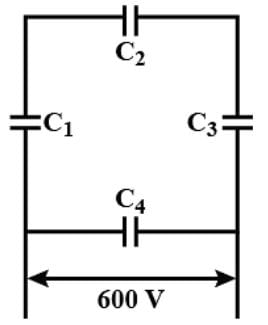
- a)4 × 10−3C, 12 × 10−3C
- b)6 × 10−3C, 12 × 10−3C
- c)2 × 10−3C, 4 × 10−3C
- d)3 × 10−3C, 2 × 10−3C
Correct answer is option 'A'. Can you explain this answer?
The charge on capacitors C1 and C4 are


a)
4 × 10−3C, 12 × 10−3C
b)
6 × 10−3C, 12 × 10−3C
c)
2 × 10−3C, 4 × 10−3C
d)
3 × 10−3C, 2 × 10−3C
|
|
Jyoti Sengupta answered |
Charge on each capacitor C1, C2, C3 is same = q
Let charge on C4 be q.
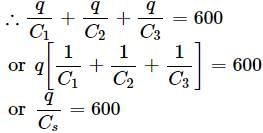

Also qC4 = 600
or q = C4 × 600μC = 20 × 600μC = 12 × 10−3C
Let charge on C4 be q.


Also qC4 = 600
or q = C4 × 600μC = 20 × 600μC = 12 × 10−3C
An electric dipole is placed at the centre of a hollow conducting sphere. Which of the following is correct?- a)Electric field is zero at every point of the sphere
- b)Electric field is not zero anywhere on the sphere
- c)The flux of electric field is not zero through the sphere
- d)All of these
Correct answer is option 'B'. Can you explain this answer?
An electric dipole is placed at the centre of a hollow conducting sphere. Which of the following is correct?
a)
Electric field is zero at every point of the sphere
b)
Electric field is not zero anywhere on the sphere
c)
The flux of electric field is not zero through the sphere
d)
All of these
|
|
Mira Joshi answered |
When electric dipole is held in the sphere, electric field is not zero anywhere on the sphere. However, net electric flux through the sphere is zero.
A parallel plate capacitor has two square plates with equal and opposite charges. The surface charge densities on the plate are +σ and −σ respectively. In the region between the plates the magnitude of electric field is:- a)σ/2ε0
- b)σ/ε0
- c)0
- d)none of these
Correct answer is option 'B'. Can you explain this answer?
A parallel plate capacitor has two square plates with equal and opposite charges. The surface charge densities on the plate are +σ and −σ respectively. In the region between the plates the magnitude of electric field is:
a)
σ/2ε0
b)
σ/ε0
c)
0
d)
none of these
|
|
Meera Singh answered |
The magnitude of the electric field between the plates is F = σ/2ε0 - (- σ/2ε0) - σ/ε0
Two metal spheres, one of radius R and the other of radius 2R, both have the same surface density σ. If they are brought in contact and separated, then the new surface charge densities on each of the sphere are respectively- a)

- b)

- c)

- d)

Correct answer is option 'B'. Can you explain this answer?
Two metal spheres, one of radius R and the other of radius 2R, both have the same surface density σ. If they are brought in contact and separated, then the new surface charge densities on each of the sphere are respectively
a)

b)

c)

d)

|
|
Mira Joshi answered |
Before contact, Charges of each sphered,
q1 = σ4πR2; q2 = σ4π(2R)2 = 4q1
When the two sphere are brought in contact, their charges are shared till their potentials become equal i.e., V1 = V2

∴ q2′ = 2q1′....(i)
As there is no loss of charge in the process
∴ q1′ + q2′ = q1 + q2 = q1 + 4q1 = 5q1 = 5(σ4πR2)
or q1′ + 2q1′ = 5σ4πR2 (using (i))

q1 = σ4πR2; q2 = σ4π(2R)2 = 4q1
When the two sphere are brought in contact, their charges are shared till their potentials become equal i.e., V1 = V2

∴ q2′ = 2q1′....(i)
As there is no loss of charge in the process
∴ q1′ + q2′ = q1 + q2 = q1 + 4q1 = 5q1 = 5(σ4πR2)
or q1′ + 2q1′ = 5σ4πR2 (using (i))

If a conductor has a potential V≠0 and there are no charges anywhere else outside, then- a)there must be charges on the surface or inside itself.
- b)there cannot be any charge in the body of the conductor.
- c)there must be charges only on the surface.
- d)both (a) and (b) are correct.
Correct answer is option 'C'. Can you explain this answer?
If a conductor has a potential V≠0 and there are no charges anywhere else outside, then
a)
there must be charges on the surface or inside itself.
b)
there cannot be any charge in the body of the conductor.
c)
there must be charges only on the surface.
d)
both (a) and (b) are correct.
|
|
Dev Patel answered |
If a conductor has a non zero potential and there are no charge anywhere else outside, then there must be charge on the surface of the conductor or inside the conductor. There cannot be any charge in the body of the conductor.
A parallel plate capacitor is connected across a 2V battery and charged. The battery is then disconnected and a glass slab is introduced between plates. Which of the following pairs of quantities decreases?- a)Charge and potential difference
- b)Potential difference and energy stored
- c)Energy stored and capacitance
- d)Capacitance and charge
Correct answer is option 'B'. Can you explain this answer?
A parallel plate capacitor is connected across a 2V battery and charged. The battery is then disconnected and a glass slab is introduced between plates. Which of the following pairs of quantities decreases?
a)
Charge and potential difference
b)
Potential difference and energy stored
c)
Energy stored and capacitance
d)
Capacitance and charge
|
|
Gaurav Kumar answered |
When battery is disconnected, charge remains constant. On introducing glass slab, capacity increases, Potential difference and energy stored decreases.
A parallel plate air capacitor is charged to a potential difference of V volts. After disconnecting the charging battery the distance between the plates of the capacitor is increased using an insulating handle. As a result the potential difference between the plates
- a)increases
- b)decreases
- c)does not change
- d)becomes zero
Correct answer is option 'A'. Can you explain this answer?
A parallel plate air capacitor is charged to a potential difference of V volts. After disconnecting the charging battery the distance between the plates of the capacitor is increased using an insulating handle. As a result the potential difference between the plates
a)
increases
b)
decreases
c)
does not change
d)
becomes zero
|
|
Nandini Sharma answered |
Explanation:
When a capacitor is charged, it stores electrical energy in the form of electric field between its plates. The potential difference between the plates is directly proportional to the amount of charge stored in the capacitor, and inversely proportional to the distance between the plates.
When the distance between the plates is increased, the capacitance of the capacitor decreases. This means that the same amount of charge stored in the capacitor is now distributed over a larger area, resulting in a decrease in the potential difference between the plates.
However, since the capacitor is initially charged to a potential difference of V volts, it still contains that amount of charge even after the distance between the plates is increased. This means that the same amount of charge is now distributed over a larger area, resulting in a lower electric field strength between the plates.
Since the electric field strength is directly proportional to the potential difference between the plates, and the distance between the plates has increased, the potential difference between the plates increases to maintain the same electric field strength.
Therefore, the correct answer is option 'A': the potential difference between the plates increases.
When a capacitor is charged, it stores electrical energy in the form of electric field between its plates. The potential difference between the plates is directly proportional to the amount of charge stored in the capacitor, and inversely proportional to the distance between the plates.
When the distance between the plates is increased, the capacitance of the capacitor decreases. This means that the same amount of charge stored in the capacitor is now distributed over a larger area, resulting in a decrease in the potential difference between the plates.
However, since the capacitor is initially charged to a potential difference of V volts, it still contains that amount of charge even after the distance between the plates is increased. This means that the same amount of charge is now distributed over a larger area, resulting in a lower electric field strength between the plates.
Since the electric field strength is directly proportional to the potential difference between the plates, and the distance between the plates has increased, the potential difference between the plates increases to maintain the same electric field strength.
Therefore, the correct answer is option 'A': the potential difference between the plates increases.
Two identical capacitors are joined in parallel, charged to a potential V, separated and then connected in series, the positive plate of one is connected to the negative of the other. Which of the following is true?- a)The charges on the free plated connected together are destroyed.
- b)The energy stored in the system increases.
- c)The potential difference between the free plates is 2 V.
- d)The potential difference remains constant.
Correct answer is option 'C'. Can you explain this answer?
Two identical capacitors are joined in parallel, charged to a potential V, separated and then connected in series, the positive plate of one is connected to the negative of the other. Which of the following is true?
a)
The charges on the free plated connected together are destroyed.
b)
The energy stored in the system increases.
c)
The potential difference between the free plates is 2 V.
d)
The potential difference remains constant.
|
|
Rithika Bose answered |
Explanation:
When two identical capacitors are joined in parallel and charged to a potential V, the charges on the plates are equal and have the same magnitude. Let's assume that each capacitor has a charge of Q.
1. Charges on the free plates:
When the capacitors are separated and then connected in series, the positive plate of one capacitor is connected to the negative plate of the other capacitor. This means that the positive charges on one plate will attract the negative charges on the other plate, resulting in a redistribution of charges.
The charges on the free plates connected together are not destroyed. Instead, the positive plate of one capacitor will have a net positive charge and the negative plate of the other capacitor will have a net negative charge. These charges will remain on the plates even after they are connected together.
2. Energy stored in the system:
The energy stored in a capacitor is given by the formula: E = 1/2 * C * V^2, where E is the energy, C is the capacitance, and V is the potential difference.
When the capacitors are joined in parallel, the total capacitance of the system is doubled, but the potential difference remains the same. Therefore, the energy stored in the system increases because the capacitance has increased.
3. Potential difference between the free plates:
When the capacitors are connected in series, the potential difference across each capacitor is the same. In this case, since the capacitors are identical, the potential difference across each capacitor is V.
Since the positive plate of one capacitor is connected to the negative plate of the other capacitor, the potential difference between the free plates is the sum of the potential differences across each capacitor. Therefore, the potential difference between the free plates is 2V.
4. Potential difference remains constant:
The potential difference across each capacitor remains constant when they are connected in series. However, the potential difference between the free plates is not constant in this case. As explained earlier, it is 2V.
Therefore, the correct answer is option 'c' - the potential difference between the free plates is 2V.
When two identical capacitors are joined in parallel and charged to a potential V, the charges on the plates are equal and have the same magnitude. Let's assume that each capacitor has a charge of Q.
1. Charges on the free plates:
When the capacitors are separated and then connected in series, the positive plate of one capacitor is connected to the negative plate of the other capacitor. This means that the positive charges on one plate will attract the negative charges on the other plate, resulting in a redistribution of charges.
The charges on the free plates connected together are not destroyed. Instead, the positive plate of one capacitor will have a net positive charge and the negative plate of the other capacitor will have a net negative charge. These charges will remain on the plates even after they are connected together.
2. Energy stored in the system:
The energy stored in a capacitor is given by the formula: E = 1/2 * C * V^2, where E is the energy, C is the capacitance, and V is the potential difference.
When the capacitors are joined in parallel, the total capacitance of the system is doubled, but the potential difference remains the same. Therefore, the energy stored in the system increases because the capacitance has increased.
3. Potential difference between the free plates:
When the capacitors are connected in series, the potential difference across each capacitor is the same. In this case, since the capacitors are identical, the potential difference across each capacitor is V.
Since the positive plate of one capacitor is connected to the negative plate of the other capacitor, the potential difference between the free plates is the sum of the potential differences across each capacitor. Therefore, the potential difference between the free plates is 2V.
4. Potential difference remains constant:
The potential difference across each capacitor remains constant when they are connected in series. However, the potential difference between the free plates is not constant in this case. As explained earlier, it is 2V.
Therefore, the correct answer is option 'c' - the potential difference between the free plates is 2V.
Two capacitors of 2 μF and 4 μF are connected in parallel. A third capacitor of 6 μF is connected in series. The combination is connected across a 12 V battery. The voltage across 2 μF capacitor is- a)2 V
- b)8 V
- c)6 V
- d)1 V
Correct answer is option 'C'. Can you explain this answer?
Two capacitors of 2 μF and 4 μF are connected in parallel. A third capacitor of 6 μF is connected in series. The combination is connected across a 12 V battery. The voltage across 2 μF capacitor is
a)
2 V
b)
8 V
c)
6 V
d)
1 V
|
|
Dev Patel answered |
Cp = 2 + 4 = 6μF

Total Q = CV = 3 × 12 = 36μF
Voltage across 6μF capacitor = 36μC/6μF = 6V
∴ Voltage across each of 2μF and 4μF capacitors = 12V - 6V
V = 6V
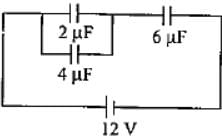

Total Q = CV = 3 × 12 = 36μF
Voltage across 6μF capacitor = 36μC/6μF = 6V
∴ Voltage across each of 2μF and 4μF capacitors = 12V - 6V
V = 6V

Minimum number of capacitors each of 8μF and 250V used to make a composite capacitor of 16μF and 1000V are- a)8
- b)32
- c)16
- d)24
Correct answer is option 'B'. Can you explain this answer?
Minimum number of capacitors each of 8μF and 250V used to make a composite capacitor of 16μF and 1000V are
a)
8
b)
32
c)
16
d)
24
|
|
Geetika Shah answered |
Minimum number of capacitors in each row = 1000/250 = 4
Therefore, 4 capacitors connected in series.
If there are m such rows, that total capacity
= m × 2 = 16 ∴ m = 16/28
∴ minimum number of capacitors = 4 × 8 = 32
Therefore, 4 capacitors connected in series.
If there are m such rows, that total capacity
= m × 2 = 16 ∴ m = 16/28
∴ minimum number of capacitors = 4 × 8 = 32
Two tiny spheres carrying charges 1.8 μC and 2.8μC are located at 40 cm apart. The potential at the mid-point of the line joining the two charges is- a)3.8 × 104 V
- b)2.1 × 105 V
- c)4.3 × 104 V
- d)3.6 × 105 V
Correct answer is option 'B'. Can you explain this answer?
Two tiny spheres carrying charges 1.8 μC and 2.8μC are located at 40 cm apart. The potential at the mid-point of the line joining the two charges is
a)
3.8 × 104 V
b)
2.1 × 105 V
c)
4.3 × 104 V
d)
3.6 × 105 V
|
|
Riya Banerjee answered |
Here q1 = 1.8 μC = 1.8 × 10−6 C, q2 = 2.8 μC = 2.8 × 10−6C

Distance between the two spheres = 40 cm = 0.4 m
For the mid-point r1 = r2 = 0.40/2 = 0.2 m Potential at O,


Distance between the two spheres = 40 cm = 0.4 m
For the mid-point r1 = r2 = 0.40/2 = 0.2 m Potential at O,

Two points A and B are located in diametrically opposite directions of a point charge of +2μC at distances 2m and 1m respectively from it. The potential difference between A and B is- a)3 × 103V
- b)6 × 104V
- c)−9 × 103V
- d)−3 × 103V
Correct answer is option 'C'. Can you explain this answer?
Two points A and B are located in diametrically opposite directions of a point charge of +2μC at distances 2m and 1m respectively from it. The potential difference between A and B is
a)
3 × 103V
b)
6 × 104V
c)
−9 × 103V
d)
−3 × 103V
|
|
Priya Menon answered |
Here, q = 2 μC = 2 × 10−6 C,
rA = 2m, rB = 1m

= −9 × 103 V
rA = 2m, rB = 1m

= −9 × 103 V
The potential at a point due to a charge of 5×10−7C located 10cm10cm away is- a)3.5 × 105V
- b)3.5 × 104V
- c)4.5 × 104V
- d)4.5 × 105V
Correct answer is option 'C'. Can you explain this answer?
The potential at a point due to a charge of 5×10−7C located 10cm10cm away is
a)
3.5 × 105V
b)
3.5 × 104V
c)
4.5 × 104V
d)
4.5 × 105V
|
|
Dev Patel answered |
Here, q = 5 × 10(−7) C, r = 10 cm = 0.1 m


Equipotential surfaces- a)are closer in regions of large electric fields compared to regions of lower electric fields
- b)will be more crowded near sharp edges of a conductor
- c)will always be equally spaced
- d)both (a) and (b) are correct
Correct answer is option 'D'. Can you explain this answer?
Equipotential surfaces
a)
are closer in regions of large electric fields compared to regions of lower electric fields
b)
will be more crowded near sharp edges of a conductor
c)
will always be equally spaced
d)
both (a) and (b) are correct
|
|
Dev Patel answered |
Electric field,

i.e., equipotential surfaces are closer in regions of large electric fields compared to regions of lower electric field. At sharp edges of a conductor, charge density is more. Therefore electric field is stronger. Hence equipotential surfaces are more crowded.

i.e., equipotential surfaces are closer in regions of large electric fields compared to regions of lower electric field. At sharp edges of a conductor, charge density is more. Therefore electric field is stronger. Hence equipotential surfaces are more crowded.
Which of the following statement is not true?- a)Electrostatic force is a conservative force.
- b)Potential at a point is the work done per unit charge in bringing a charge from any point to infinity.
- c)Electrostatic force is non-conservative.
- d)Potential is the product of charge and work.
Correct answer is option 'B'. Can you explain this answer?
Which of the following statement is not true?
a)
Electrostatic force is a conservative force.
b)
Potential at a point is the work done per unit charge in bringing a charge from any point to infinity.
c)
Electrostatic force is non-conservative.
d)
Potential is the product of charge and work.
|
|
Mira Joshi answered |
Work done by the electrostatic force is independent of the path followed by it, and it depends only on the initial and final positions. For example, work done in moving a unit positive charge in a closed loop of an electric field is zero.
The electric field intensity at a point P due to point charge q kept at point Q is 24 N C−1 and the electric potential at point P due to same charge is 12 J C−1. The order of magnitude of charge q is- a)10−6 C
- b)10−7 C
- c)10−10 C
- d)10−9 C
Correct answer is option 'D'. Can you explain this answer?
The electric field intensity at a point P due to point charge q kept at point Q is 24 N C−1 and the electric potential at point P due to same charge is 12 J C−1. The order of magnitude of charge q is
a)
10−6 C
b)
10−7 C
c)
10−10 C
d)
10−9 C
|
|
Suresh Iyer answered |
Electric field of a point charge.

Electric potential of a point charge,

The distance PQ is r = V/E = 12/24 = 0.5 m
∴ Magnitude of charge
q' = 4πε0Vr

= 10−9 C

Electric potential of a point charge,

The distance PQ is r = V/E = 12/24 = 0.5 m
∴ Magnitude of charge
q' = 4πε0Vr

= 10−9 C
Energy stored in a capacitor and dissipated during charging a capacitor bear a ratio.- a)1 : 1
- b)1 : 2
- c)2 : 1
- d)1 : 3
Correct answer is option 'C'. Can you explain this answer?
Energy stored in a capacitor and dissipated during charging a capacitor bear a ratio.
a)
1 : 1
b)
1 : 2
c)
2 : 1
d)
1 : 3
|
|
Geetika Shah answered |
Half of the energy is dissipated during charging a capacitor.


A capacitor is charged through a potential difference of 200 V, when 0.1 C charge is stored in it. The amount of energy released by it, when it is discharged is- a)5 J
- b)10 J
- c)20 J
- d)2.5 J
Correct answer is option 'B'. Can you explain this answer?
A capacitor is charged through a potential difference of 200 V, when 0.1 C charge is stored in it. The amount of energy released by it, when it is discharged is
a)
5 J
b)
10 J
c)
20 J
d)
2.5 J
|
|
Shanaya Basak answered |
Given Information:
A capacitor is charged through a potential difference of 200 V.
0.1 C charge is stored in the capacitor.
Explanation:
The energy stored in a capacitor is given by the formula:
E = (1/2) * C * V^2
Where:
E is the energy stored in the capacitor
C is the capacitance
V is the potential difference across the capacitor
Calculating Energy Stored:
Given that the potential difference across the capacitor is 200 V and the charge stored is 0.1 C, we can calculate the capacitance using the formula:
C = Q / V
Where:
C is the capacitance
Q is the charge stored in the capacitor
V is the potential difference across the capacitor
Substituting the given values:
C = 0.1 C / 200 V = 0.0005 F
Now, we can calculate the energy stored in the capacitor using the formula:
E = (1/2) * C * V^2
Substituting the values:
E = (1/2) * 0.0005 F * (200 V)^2 = 0.02 J = 20 J
Conclusion:
The amount of energy released by the capacitor when it is discharged is 20 J. Therefore, the correct answer is option B) 10 J.
In the question number 18, the potential at a point 20cm from the mid-point of the line joining the two charges in a plane normal to the line and passing through the mid-point is- a)1.4 × 105 V
- b)4.2 × 103 V
- c)2.9 × 104 V
- d)3.7 × 105 V
Correct answer is option 'A'. Can you explain this answer?
In the question number 18, the potential at a point 20cm from the mid-point of the line joining the two charges in a plane normal to the line and passing through the mid-point is
a)
1.4 × 105 V
b)
4.2 × 103 V
c)
2.9 × 104 V
d)
3.7 × 105 V
|
|
Priya Menon answered |
From the figure, potential at P,
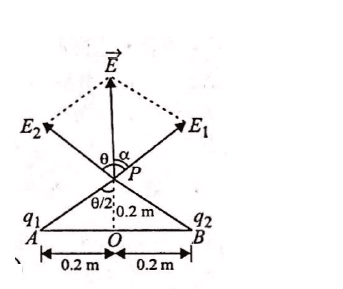







A metallic sphere of radius 18 cm has been given a charge of 5 × 10−6 C. The energy of the charged conductor is- a)0.2 J
- b)0.6 J
- c)1.2 J
- d)2.4 J
Correct answer is option 'B'. Can you explain this answer?
A metallic sphere of radius 18 cm has been given a charge of 5 × 10−6 C. The energy of the charged conductor is
a)
0.2 J
b)
0.6 J
c)
1.2 J
d)
2.4 J
|
|
Jyoti Sengupta answered |
Here r = 18cm = 18 × 10−2m, q = 5 × 10−6C

Energy of charged conductor is


Energy of charged conductor is

Which of the following is not true?- a)For a point charge, electrostatic potential varies as 1/r
- b)For a dipole, the potential depends on the magnitude of position vector and dipole moment vector
- c)The electric dipole potential varies as 1/r at large distance
- d)For a point charge, the electrostatic field varies as 1/r2
Correct answer is option 'C'. Can you explain this answer?
Which of the following is not true?
a)
For a point charge, electrostatic potential varies as 1/r
b)
For a dipole, the potential depends on the magnitude of position vector and dipole moment vector
c)
The electric dipole potential varies as 1/r at large distance
d)
For a point charge, the electrostatic field varies as 1/r2
|
|
Parth Sharma answered |
Electric Dipole Potential
The statement that the electric dipole potential varies as 1/r at large distances is not true. Let's break down the concept of electric dipole potential to understand why this statement is incorrect.
Electric Dipole
- An electric dipole consists of two equal and opposite charges separated by a small distance.
- The electric dipole moment is defined as the product of the magnitude of one of the charges and the separation between the charges.
Electric Dipole Potential
- The electric potential due to an electric dipole at a point in space is given by the formula: V = k * p * cosθ / r^2, where V is the potential, k is the electrostatic constant, p is the dipole moment, θ is the angle between the dipole moment vector and the position vector, and r is the distance from the dipole.
- As we can see from the formula, the potential due to an electric dipole varies as 1/r^2, not 1/r, at large distances.
- This is because the electric potential due to an electric dipole decreases with distance according to the inverse square law, similar to the electric field of a point charge.
Therefore, the statement that the electric dipole potential varies as 1/r at large distances is not true, as the correct relationship is 1/r^2.
The statement that the electric dipole potential varies as 1/r at large distances is not true. Let's break down the concept of electric dipole potential to understand why this statement is incorrect.
Electric Dipole
- An electric dipole consists of two equal and opposite charges separated by a small distance.
- The electric dipole moment is defined as the product of the magnitude of one of the charges and the separation between the charges.
Electric Dipole Potential
- The electric potential due to an electric dipole at a point in space is given by the formula: V = k * p * cosθ / r^2, where V is the potential, k is the electrostatic constant, p is the dipole moment, θ is the angle between the dipole moment vector and the position vector, and r is the distance from the dipole.
- As we can see from the formula, the potential due to an electric dipole varies as 1/r^2, not 1/r, at large distances.
- This is because the electric potential due to an electric dipole decreases with distance according to the inverse square law, similar to the electric field of a point charge.
Therefore, the statement that the electric dipole potential varies as 1/r at large distances is not true, as the correct relationship is 1/r^2.
Three capacitors each of capacity 4 μF are to be connected in such a way that the effective capacitance is 6 μF. This can be done by- a)connecting all of them in series
- b)connecting them in parallel
- c)connecting two in series and one in parallel
- d)connecting two in parallel and one in series
Correct answer is option 'C'. Can you explain this answer?
Three capacitors each of capacity 4 μF are to be connected in such a way that the effective capacitance is 6 μF. This can be done by
a)
connecting all of them in series
b)
connecting them in parallel
c)
connecting two in series and one in parallel
d)
connecting two in parallel and one in series
|
|
Suresh Iyer answered |
To get equivalent capacitance 6 μF. Out of the 4 μF capacitance, two are connected in series and third one is connected in parallel.
A parallel plate capacitor of capacitance 5μF and plate separation 6 cm is connected to a 1 v battery and charged. A dielectric of dielectric constant 4 and thickness 4 cm is introduced between the plates of the capacitor. The additional charge that flows into the capacitor from the battery is- a)2μc
- b)3μc
- c)5μc
- d)10μc
Correct answer is option 'C'. Can you explain this answer?
A parallel plate capacitor of capacitance 5μF and plate separation 6 cm is connected to a 1 v battery and charged. A dielectric of dielectric constant 4 and thickness 4 cm is introduced between the plates of the capacitor. The additional charge that flows into the capacitor from the battery is
a)
2μc
b)
3μc
c)
5μc
d)
10μc
|
|
Riya Banerjee answered |
as Q = cv
initially c = 5μF, v = 1v
∴ Q = 5 × 10–6 c = 5μc
when dielectric is introduced, let capacitance be c'
∴ c' = [(A∈0)/{d – t + (t/k)}]
here k = 4, t = 4 cm, d = 6 cm
∴ c' = [{(A∈0)/d}/{{d – t + (t/k)}/d}] ------ dividing by d
As [(A∈0)/d] = initially capacitance = c = 5μF
∴ c' = [c/{{6 – 4 + (4/4)}/6}] = [c/(3/6)] = 2c = 10μF
∴ Q' = c'v = 10 × 10–6 × 1 = 10μc
∴ addition charge flowing = Q' – Q = 10 – 5 = 5μc
initially c = 5μF, v = 1v
∴ Q = 5 × 10–6 c = 5μc
when dielectric is introduced, let capacitance be c'
∴ c' = [(A∈0)/{d – t + (t/k)}]
here k = 4, t = 4 cm, d = 6 cm
∴ c' = [{(A∈0)/d}/{{d – t + (t/k)}/d}] ------ dividing by d
As [(A∈0)/d] = initially capacitance = c = 5μF
∴ c' = [c/{{6 – 4 + (4/4)}/6}] = [c/(3/6)] = 2c = 10μF
∴ Q' = c'v = 10 × 10–6 × 1 = 10μc
∴ addition charge flowing = Q' – Q = 10 – 5 = 5μc
In the question number 4, work done in bringing a charge of 4 x 10-9 C from infinity to that point is- a)2.4 × 10−4J
- b)1.8 × 10−4J
- c)3.2 × 10−5J
- d)4.1×10−5J
Correct answer is option 'B'. Can you explain this answer?
In the question number 4, work done in bringing a charge of 4 x 10-9 C from infinity to that point is
a)
2.4 × 10−4J
b)
1.8 × 10−4J
c)
3.2 × 10−5J
d)
4.1×10−5J
|
|
Yash Majumdar answered |
To calculate the work done in bringing a charge from infinity to a certain point, we need to use the equation for electric potential energy:
Work = q * ΔV
Where q is the charge and ΔV is the change in electric potential.
In this case, the charge is 4 x 10^-9 C. We need to find the electric potential at the point where the charge is brought.
The equation for electric potential is:
V = k * (q / r)
Where k is the electrostatic constant (approximately 9 x 10^9 Nm^2/C^2), q is the charge, and r is the distance from the charge.
Since the charge is being brought from infinity, we can assume that the distance r is very large, approaching infinity. In this case, the electric potential at that point is 0.
Therefore, the change in electric potential is:
ΔV = 0 - 0 = 0
Plugging this into the equation for work:
Work = q * ΔV = (4 x 10^-9 C) * 0 = 0
So the work done in bringing a charge of 4 x 10^-9 C from infinity to that point is 0.
Work = q * ΔV
Where q is the charge and ΔV is the change in electric potential.
In this case, the charge is 4 x 10^-9 C. We need to find the electric potential at the point where the charge is brought.
The equation for electric potential is:
V = k * (q / r)
Where k is the electrostatic constant (approximately 9 x 10^9 Nm^2/C^2), q is the charge, and r is the distance from the charge.
Since the charge is being brought from infinity, we can assume that the distance r is very large, approaching infinity. In this case, the electric potential at that point is 0.
Therefore, the change in electric potential is:
ΔV = 0 - 0 = 0
Plugging this into the equation for work:
Work = q * ΔV = (4 x 10^-9 C) * 0 = 0
So the work done in bringing a charge of 4 x 10^-9 C from infinity to that point is 0.
Which of the following statements is true about the relation between electric field and potential?- a)Electric field is in the direction in which the potential decreases steepest.
- b)Magnitude of electric field is given by the change in the magnitude of potential per unit displacement normal to the equipotential surface at that point.
- c)In the region of strong electric field, equipotential surfaces are far apart.
- d)Both the statements (a) and (b) are correct.
Correct answer is option 'D'. Can you explain this answer?
Which of the following statements is true about the relation between electric field and potential?
a)
Electric field is in the direction in which the potential decreases steepest.
b)
Magnitude of electric field is given by the change in the magnitude of potential per unit displacement normal to the equipotential surface at that point.
c)
In the region of strong electric field, equipotential surfaces are far apart.
d)
Both the statements (a) and (b) are correct.
|
|
Hansa Sharma answered |
In the region of strong electric fields equipotential surfaces are close together and in the region of weak electric fields, equipotential surfaces are far apart.
A capacitor has some dielectric between its plates, and the capacitor is connected to a dc source. The battery is now disconnected and then the dielectric is removed, then- a)capacitance will increase.
- b)energy stored will decrease.
- c)electric field will increase.
- d)voltage will decrease.
Correct answer is option 'C'. Can you explain this answer?
A capacitor has some dielectric between its plates, and the capacitor is connected to a dc source. The battery is now disconnected and then the dielectric is removed, then
a)
capacitance will increase.
b)
energy stored will decrease.
c)
electric field will increase.
d)
voltage will decrease.
|
|
Ananya Das answered |
When the capacitor is connected to dc source, it gets charged. The battery is then disconnected, so no more charge can flow in. On removing dielectric capacitance decrease.
Energy stored (u = q2/2C) will increase.
Potential (V = q/C) will also increase.
Electric field (E = V/D) will increase.
Energy stored (u = q2/2C) will increase.
Potential (V = q/C) will also increase.
Electric field (E = V/D) will increase.
The electric potential at a point in free space due to charge Q coulomb is Q x 1011 volts. The electric field at that point is- a)12πε0Q x 1020 volt/m-1
- b)4πε0Q x 1022 volt/m-1
- c)12πε0Q x 1022 volt/m-1
- d)4πε0Q x 1020 volt/m-1
Correct answer is option 'B'. Can you explain this answer?
The electric potential at a point in free space due to charge Q coulomb is Q x 1011 volts. The electric field at that point is
a)
12πε0Q x 1020 volt/m-1
b)
4πε0Q x 1022 volt/m-1
c)
12πε0Q x 1022 volt/m-1
d)
4πε0Q x 1020 volt/m-1
|
|
Hansa Sharma answered |
The electric potential due to charge Q is

where r is the distance of observation point from the charge. At the same point, electric field is

Combining Eqs. (i) and (ii), we have

= 4πε0Q × 1022 V/m-1

where r is the distance of observation point from the charge. At the same point, electric field is

Combining Eqs. (i) and (ii), we have

= 4πε0Q × 1022 V/m-1
The capacitance of a parallel plate capacitor with air as medium is 3μF. With the introduction of a dielectric medium between the plates, the capacitance becomes 15μF. The permittivity of the medium is- a)5C2N−1m−2
- b)10C2N−1m−2
- c)0.44 × 10−10C2N−1m−2
- d)8.854 × 10−11C2N−1m−2
Correct answer is option 'C'. Can you explain this answer?
The capacitance of a parallel plate capacitor with air as medium is 3μF. With the introduction of a dielectric medium between the plates, the capacitance becomes 15μF. The permittivity of the medium is
a)
5C2N−1m−2
b)
10C2N−1m−2
c)
0.44 × 10−10C2N−1m−2
d)
8.854 × 10−11C2N−1m−2
|
|
Suresh Iyer answered |
Capacitance of a parallel capacitor with air is C = ε0A/d
Capacitance of a same parallel plate capacitor with the introduction of a dielectric medium is C ′ = Kε0A/d
where K is the dielectric constant of a medium
or C′/C = K or K = 15/3 = 5 or K = ε0/ε
or ε = Kε0 = 5 × 8.854 × 10−12 = 0.44 × 10−10C2N −1 m−2
Capacitance of a same parallel plate capacitor with the introduction of a dielectric medium is C ′ = Kε0A/d
where K is the dielectric constant of a medium
or C′/C = K or K = 15/3 = 5 or K = ε0/ε
or ε = Kε0 = 5 × 8.854 × 10−12 = 0.44 × 10−10C2N −1 m−2
A parallel plate capacitor is charged and then isolated. What is the effect of increasing the plate separation on charge, potential, capacitance, respectively?- a)constant, decreases, decreases
- b)increases, decreases, decreases
- c)constant, decreases, increases
- d)constant, increases, decreases
Correct answer is option 'D'. Can you explain this answer?
A parallel plate capacitor is charged and then isolated. What is the effect of increasing the plate separation on charge, potential, capacitance, respectively?
a)
constant, decreases, decreases
b)
increases, decreases, decreases
c)
constant, decreases, increases
d)
constant, increases, decreases
|
|
Riya Banerjee answered |
As the capacitor is isolated after charging, charge on it remains constant. Plate separation increases d, decreases C = ϵ0A/d and hence increases potential V = q/C.
Consider a uniform electric field in the z-direction. The potential is a constant- a)for any x for a given z
- b)for any y for a given z
- c)on the x-y plane for a given z
- d)all of these
Correct answer is option 'D'. Can you explain this answer?
Consider a uniform electric field in the z-direction. The potential is a constant
a)
for any x for a given z
b)
for any y for a given z
c)
on the x-y plane for a given z
d)
all of these
|
|
Suresh Iyer answered |
As the electric field in the z-direction is uniform, equipotential surfaces are in xy plane. Hence the potential for given z is constant on x-y plane, for any x in this plane and for any y in this plane. So all are correct.
Consider two conducting spheres of radii R1 and R2 with R1 > R2. If the two are at the same potential, and the larger sphere has more charge than the smaller sphere, then- a)the charge density of smaller sphere is less then that of larger sphere.
- b)the charge density of smaller sphere is more than that of larger sphere.
- c)both spheres may have same charge density.
- d)none of these.
Correct answer is option 'B'. Can you explain this answer?
Consider two conducting spheres of radii R1 and R2 with R1 > R2. If the two are at the same potential, and the larger sphere has more charge than the smaller sphere, then
a)
the charge density of smaller sphere is less then that of larger sphere.
b)
the charge density of smaller sphere is more than that of larger sphere.
c)
both spheres may have same charge density.
d)
none of these.
|
|
Dev Patel answered |
Here V1 = V2 or 
∴ q1q2 = R1R2 ......(i)
Given R1 > R2
∴ q1 > q2
∴ Larger sphere has more charge than the smaller sphere. Now charge densities.


As R1 > R2 therefore σ2 > σ1
Charge density of smaller sphere is more thatn the charge density of large sphere.

∴ q1q2 = R1R2 ......(i)
Given R1 > R2
∴ q1 > q2
∴ Larger sphere has more charge than the smaller sphere. Now charge densities.


As R1 > R2 therefore σ2 > σ1
Charge density of smaller sphere is more thatn the charge density of large sphere.
Which of the following statements is/are true about the principle of Van de Graaff generator?- a)The action of sharp points.
- b)The charge given to a hollow conductor is transferred to outer surface and is distributed uniformly over it.
- c)It is used for accelerating uncharged particle.
- d)Both(a) and (b) are true.
Correct answer is option 'D'. Can you explain this answer?
Which of the following statements is/are true about the principle of Van de Graaff generator?
a)
The action of sharp points.
b)
The charge given to a hollow conductor is transferred to outer surface and is distributed uniformly over it.
c)
It is used for accelerating uncharged particle.
d)
Both(a) and (b) are true.
|
|
Riya Banerjee answered |
Van de Graff generator- is an electrostatic generator which is devised to produce very high voltage by means of an endless belt collecting electrostatic charge from a source and transferring it to a large isolated metal sphere on which a large change accumulates.
In case of a Van de Graaff generator, the breakdown field of air is- a)2 × 108 V m−1
- b)3 × 106V m−1
- c)2 × 10−8V m−1
- d)3 × 104V m−1
Correct answer is option 'B'. Can you explain this answer?
In case of a Van de Graaff generator, the breakdown field of air is
a)
2 × 108 V m−1
b)
3 × 106V m−1
c)
2 × 10−8V m−1
d)
3 × 104V m−1
|
|
Suresh Iyer answered |
Although air is normally an insulator but at a sufficient high voltage, it ionises and become partially conducting.
The electric field at which it occurs is called breakdown field of air and is nearly equal to 3 × 106V/m-1
The electric field at which it occurs is called breakdown field of air and is nearly equal to 3 × 106V/m-1
A parallel plate capacitor without any dielectric within its plates, has a capacitance C, and is connected to a battery of emf V. The battery is disconnected and the plates of the capacitor are pulled apart until the separation between the plates is doubled. What is the work done by the agent pulling the plates apart, in this process?- a)

- b)

- c)

- d)CV2
Correct answer is option 'A'. Can you explain this answer?
A parallel plate capacitor without any dielectric within its plates, has a capacitance C, and is connected to a battery of emf V. The battery is disconnected and the plates of the capacitor are pulled apart until the separation between the plates is doubled. What is the work done by the agent pulling the plates apart, in this process?
a)

b)

c)

d)
CV2
|
|
Meera Singh answered |
Capacitance of a parallel plate capacitor is C = ε0A/d ……(i)
where A is the area of each plate and d is the distance between the plates. Initial energy stored in the capacitor,

When the separation between the plates is doubled , its capcaitance becomes

As the bettary is disconnected , so charged capacitor becomes isolated and charge on it will reamain constant ,
∴ Q = Q
C'V = C'V (AsQ = CV)

Final energy stored in the capacitor ,

Required work done,

where A is the area of each plate and d is the distance between the plates. Initial energy stored in the capacitor,

When the separation between the plates is doubled , its capcaitance becomes

As the bettary is disconnected , so charged capacitor becomes isolated and charge on it will reamain constant ,
∴ Q = Q
C'V = C'V (AsQ = CV)

Final energy stored in the capacitor ,

Required work done,

1 volt is equivalent to- a)

- b)

- c)

- d)

Correct answer is option 'C'. Can you explain this answer?
1 volt is equivalent to
a)

b)

c)

d)

|
|
Priya Menon answered |
Volt is the electrical unit of potential difference or voltage, and is expressed as V. One Volt is described as one joule of energy consumption per one coulomb electric charge.
In a Van de Graaff type generator, a spherical metal shell is to be 15 × 106 V electrode. The dielectric strength of the gas surrounding the electrode is 5 × 107 Vm−1. The minimum radius of the spherical shell required is- a)1 m
- b)2 m
- c)1.5 m
- d)3 m
Correct answer is option 'D'. Can you explain this answer?
In a Van de Graaff type generator, a spherical metal shell is to be 15 × 106 V electrode. The dielectric strength of the gas surrounding the electrode is 5 × 107 Vm−1. The minimum radius of the spherical shell required is
a)
1 m
b)
2 m
c)
1.5 m
d)
3 m
|
|
Ananya Das answered |
Here, V = 15 × 106 V, dielectric strength
= 5 x 107 V m-1
Maximum electric field, E = 10% of dielectric strength

As E = V/r

= 3 m
= 5 x 107 V m-1
Maximum electric field, E = 10% of dielectric strength

As E = V/r

= 3 m
Figure shows the field lines of a point negative charge. In going from B to A, the kinetic energy of a small negative charge will
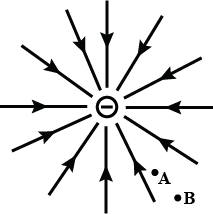
- a)increase
- b)decrease
- c)remain constant
- d)data insufficient
Correct answer is option 'B'. Can you explain this answer?
Figure shows the field lines of a point negative charge. In going from B to A, the kinetic energy of a small negative charge will


a)
increase
b)
decrease
c)
remain constant
d)
data insufficient
|
|
Hansa Sharma answered |
Due to force of repulsion on the negative charge, velocity decreases and hence the kinetic energy decreases in going from B to A.
Figure shows the field lines of a positive point charge. The work done by the field in moving a small positive charge from Q to P is
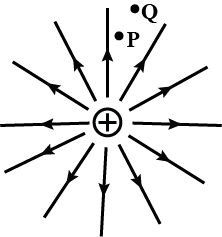
- a)zero
- b)positive
- c)negative
- d)data insufficient
Correct answer is option 'C'. Can you explain this answer?
Figure shows the field lines of a positive point charge. The work done by the field in moving a small positive charge from Q to P is


a)
zero
b)
positive
c)
negative
d)
data insufficient
|
|
Suresh Iyer answered |
In moving a small positive charge from Q to P, work has to be done by an external agency against the electric field. Therefore, work done by the field is negative.
A charge +q is placed at the origin O of x-y axes as shown in the figure. The work done in taking a charge Q from A to B along the straight line AB is
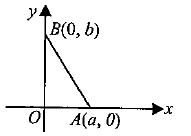
- a)

- b)

- c)

- d)

Correct answer is option 'A'. Can you explain this answer?
A charge +q is placed at the origin O of x-y axes as shown in the figure. The work done in taking a charge Q from A to B along the straight line AB is


a)

b)

c)

d)

|
|
Ananya Das answered |
Potential at point A is 
Potential at point B is
Work done in taking a charge Q from A to B is,


Potential at point B is

Work done in taking a charge Q from A to B is,

Chapter doubts & questions for Electrostatic Potential and Capacitance - NCERT Based Tests for NEET 2025 is part of NEET exam preparation. The chapters have been prepared according to the NEET exam syllabus. The Chapter doubts & questions, notes, tests & MCQs are made for NEET 2025 Exam. Find important definitions, questions, notes, meanings, examples, exercises, MCQs and online tests here.
Chapter doubts & questions of Electrostatic Potential and Capacitance - NCERT Based Tests for NEET in English & Hindi are available as part of NEET exam.
Download more important topics, notes, lectures and mock test series for NEET Exam by signing up for free.

Contact Support
Our team is online on weekdays between 10 AM - 7 PM
Typical reply within 3 hours
|
Free Exam Preparation
at your Fingertips!
Access Free Study Material - Test Series, Structured Courses, Free Videos & Study Notes and Prepare for Your Exam With Ease

 Join the 10M+ students on EduRev
Join the 10M+ students on EduRev
|

|
Create your account for free
OR
Forgot Password
OR
Signup on EduRev and stay on top of your study goals
10M+ students crushing their study goals daily


